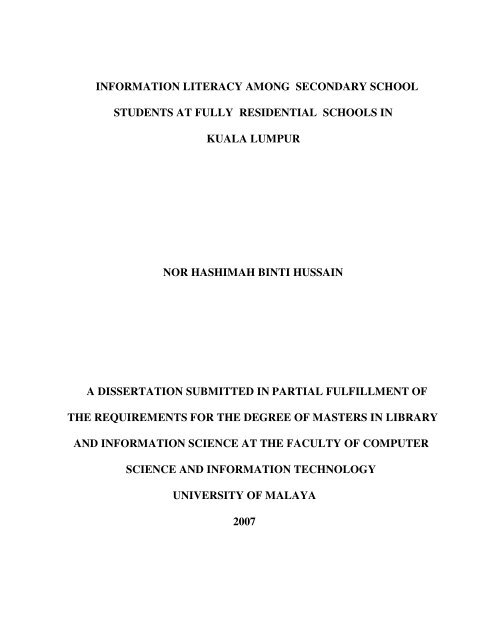information literacy among secondary school ... - DSpace@UM
information literacy among secondary school ... - DSpace@UM
information literacy among secondary school ... - DSpace@UM
You also want an ePaper? Increase the reach of your titles
YUMPU automatically turns print PDFs into web optimized ePapers that Google loves.
The Slitherers1 Productivity DefinedProductivity IIPyGO Session 29th February 2009Productivity is a measure of the output from a production process per unit input (time or cost).1.1 Labour productivityA basic definition of labour productivity is the average output per man-hour worked. In other words,it can be defined as the ratio of the output produced by the number of hours put in by the workforce:Output (units produced)Labour productivity =, where units produced may be actual units ofInput labour (time worked)goods or a physical quantity.1.2 Multifactor productivityThe basic definition is limited in what it can tell us about the productivity. A more descriptive quantityis the multifactor productivity which takes into account other performance variables to describe theproductivity. It is given by:Multifactor productivity =Output (units produced), where KLEMS signifiesKLEMSKLEMScapitallabourenergymaterialsservicesThe units of the KLEMS factors must be currency; for example, labour is given as the total cost oflabour to produce the output. Services are any additional overheads required or involved in production,such as maintenance costs. Multifactor productivity reflects changes in output dependent on awide variety of inputs.2 Worked examplesExamples taken from the online resources 1 for the course text “Operations Management” (Heizer andRollins).(1.13) John Lucy makes wooden boxes in which to ship motorcycles. John and his three employeesinvest 40 hours per day making the 120 boxes.(a) What is their productivity?(b) John and his employees have discussed redesigning the process to improve efficiency. If theycan increase the rate to 125 per day, what would be their new productivity?1 http://cwx.prenhall.com/bookbind/pubbooks/heizer2/1
TABLE OF CONTENTSPageABSTRACT………………………………………………………………………….iiACKNOWLEDGEMENT…………………………………………………………...iiiTABLE OF CONTENTS…………………………………………………………....ivLIST OF TABLES…………………………………………………………………viiiLIST OF FIGURES…………………………………………………………………xiiCHAPTER ONEINTRODUCTION1.1 Background to the Study ……………………………………………………… 11.1.1 Information Literacy……………………………………………………. 21.1.2 Information Literacy and Education…………………………..................41.1.3 Information Literacy <strong>among</strong> School Children…………………………...81.2 Statement of Problem…………………………………………………………...101.3 Scope……………………………………………………………………………121.4 Objectives of the Study…………………………………………………………121.5 Research Questions………………………………………………………….. ...131.6 Significance of the Study……………………………………………………. ...141.7 Assumptions…………………………………………………………………….141.8 Definitions of Terms……………………………………………………………151.9 Summary………………………………………………………………………..17CHAPTER TWO : REVIEW OF LITERATURE2.1 Introduction …………………………………………………………………….182.2 Concept of Information Literacy………………………………………….. …...192.3 Information Literacy Skills – The Process……………………………………...25iv
2.4 Information Literacy <strong>among</strong> Secondary School Students…………………. …..302.5 Information Literacy In Malaysia…………………………… ……………... …352.6 Information Needs…………………………..…………………………………..372.7 Information Sources Used By School Students………………………………....392.8 Instruction In Library And Information Skills…………………..……………....422.9 The Role Of School Resource Centres And Teacher Librarian…………………492.10 Summary……………………………………...………………………………...542.11 Relationship Between Findings And This Study……………………………….57CHAPTER THREE : METHODOLOGY3.1 Introduction…………………………….............................................................593.2 Research Design………………………………………………………………..603.3 Research Instrument………………………………………………………. …..623.4 Pre-Test…………………………………………………………………………653.5 The Population and Sample…………………………………………………….663.6 Data Collection Procedure……………………………………………….. …....673.7 Data Analysis…………………………………………………………………...68CHAPTER FOUR : FINDINGS4.1 Introduction………………………………………………………….. …………694.2 Data Analysis………………………………………………………….. ……….694.3 Students Background Characteristic…………………………………... ……….694.4 Information Literacy Skills……………………………………………. …….....724.5 Locating and Selecting Information…………………………………… ……....884.6 Sources of Information………………………………………………………….944.7 Programmes Conducted at School Resource Center………………….. ………105v
4.8 The Need for Information Literacy……………………………………………1074.9 Programmes Conducted at School Resource Centres by Co-Ordinators……...1144.9.1 . Opening Hours of the School Resource Centre……………………….1144.9.2 School Resource Centres’ Collections………………………………...1154.9.3 Programmes Conducted at School Resource Centre…………………..1154.9.4 Conducting The Programmes………………………………………….1164.9.5 Why Are Programmes Conducted……………………………………..1164.9.6 Frequency of the Programme…………………………………………..1164.9.7 Problems In Conducting the Programme……………………………….1164.9.8 Student Division in the Programme…………………………………….1174.9.9 Students’ Participation………………………………………………….1174.9.10 Students Evaluation…………………………………………………….1174.9.11 Students Achievement………………………………………………….1184.9.12 Information Literacy Skills Still Needed By The Students……………1184.9.13 Guidance On Any Of The Skills………………………………………1184.9.14 Skills To Be Taught First………………………………………………1184.9.15 Programmes That Should Be Conducted To Increase InformationLiteracy Skills…………………………………………………………..1184.10 Summary……………………………………………………………………...119CHAPTER FIVESUMMARY, CONCLUSION ANDIMPLICATION5.1 Summary of the Study………………………………………………... ………1225.2 Summary of the Findings………………………………………………………1235.2.1 Students Background Characteristic………. …………………………..1235.2.2 Information Literacy Skills……………………………………………..123vi
5.2.3 Locating and Selecting Information…………………………………….1255.2.4 Sources of Information………………………………………………….1265.2.5 Programmes Conducted at School Resource Center……………….1275.2.6 The Need for Information Literacy…………………..............................1275.2.7 Programmes Conducted In School Resource Center by ResourceCentre Co-Ordinator…………………………………………………...1285.2.8 Students Participation and Achievement……………………………....1295.2.9 Information Literacy Skills Needed by The Students from TeachersPerspective……………………………………………………………..1295.3 Discussion……………………………………………………………………..1295.4 Conclusions from the Study…………………………………………………...1315.5 Implications from the Study…………………………………………………...1325.6 Directions for Further Research……………………………………………….133APPENDICESAppendix AAppendix BQuestionnaire………………………………………………………...136Permission Letter……………………………………………………162REFERENCES………………………………………………………………..........163vii
Table 4.21Table 4.22Table 4.23Table 4.24Table 4.25Table 4.26Table 4.27Table 4.28Table 4.29Table 4.30Table 4.31Table4. 32Table 4. 33Table 4. 34Table 4.35Table 4.36Table 4.37Table 4.38Table 4.39Table 4.40Table 4.41Table 4.42Table 4.43Methods in Using Information………………………………………83Methods in Deciding Having Enough Information……………….....84Presentation of Assignment……………………………………….....84Writing References for Books And Article……………….................85Five Elements To Write References For Books……………..............85Writing References for Books And Article – By Form……………..86Writing References for Books And Article – By Gender…...............86Book Searching Based on Call Number……………………………86Knowledge on Bibliography………………………………................87Knowledge on Bibliography - By Form…………………..................87Knowledge on Bibliography - By Gender…………………………...87Section in The Library Choosen by the Students to Get Source ofInformation…………………………………………………………..88Assistance in Searching Information For Assignments……………..89Cross tabulation of Knowing How to Use the Call Number toSearch for Information Against Needing Assistance in SearchingInformation for Assignments………………………………………..89The Most Preferred Sources …………..……………………………90The Most Preferred Sources - By Form……………………………..90The Most Preferred Sources - By Gender ……………......................90Reasons for Choosing Printed Sources……………….......................91Reasons for Choosing Electronic Resources……………………......92Reasons for Choosing Audio Video ………………………………..92Problems Faced in Locating Information…………………………...93Problems in Selecting Information Once the Resources Are Found- By Gender…………………………………………………………93Problems in Selecting Information………………………………….94ix
Table 4.60Table 4.61Table 4.62Table 4.63Table 4.64Table 4.65Table 4.66Table 4.67Table 4.68Table 4.69Table 4.70Problems in Completing Assignment…………………………....109Problems in Completing Assignments – Detailed……….............110Problems in Completing Assignments – By Form………………111Problems in Completing Assignments – By Gender………….....111Problems in Finding Sources Of Information……………………111Problems In Finding Sources of Information – Detailed………...112Information Literacy Skills………………………………………113Information Literacy Skills – By Form…………………………..113Information Literacy Skills – By Gender………………………..114Resource Centers Collection…………………………………….115Programmes Conducted in School Resource Centres…………...115xi
LIST OF FIGURESFiguresPageFigure 1.1 The Research Cycle Model……………………………………………..7Figure 2.1Figure 4.1Model Information Literacy Comparison……………………………..27Distribution of Students According To Forms………………..............70Figure 4.2 Students Achievement In UPSR and PMR Exams…………………....71Figure 4.3 Sources of Information Preferred By Students………………………..99xii
xiii
xiv
.xv
xvi
















